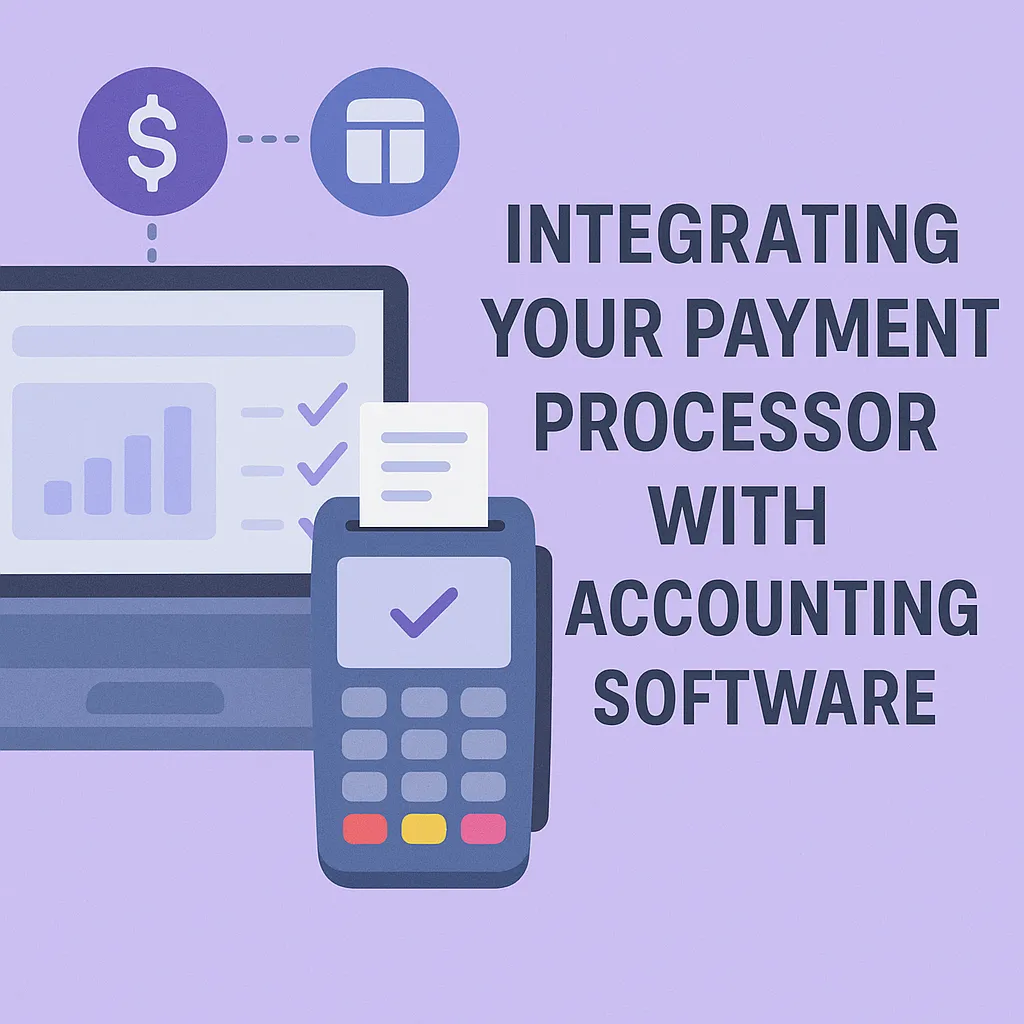
Seamless & Smart: How to Effortlessly Integrate Your Payment Processor with Accounting Software
Seamless & Smart: How to Effortlessly Integrate Your Payment Processor with Accounting Software
In the fast-paced world of business, managing payments and financial records separately is a luxury most cannot afford. Every missed reconciliation, delayed report, or manual error can snowball into costly consequences. Imagine this: a small business owner spends half a day manually entering payments from multiple platforms into their books, only to find out at tax time that hundreds of transactions don’t match up. That’s not just inefficient—it’s unsustainable.
Now imagine the opposite. Your payment processor is seamlessly connected to your accounting software. Every sale is automatically logged, every fee is tracked, and your books reconcile themselves in near real-time. You get back your time, your data is accurate, and your insights are actionable. That’s the promise of integration, and in this guide, we’ll show you exactly how to make it happen.
This blog is your comprehensive roadmap to integrating payment processors with accounting software like QuickBooks and Xero. Whether you're a business owner managing your own books or an accountant advising clients, this guide will deliver practical, expert-backed insights that help you optimize your financial workflows.
Why Integration Matters More Than Ever
Digital transformation is no longer a buzzword—it's a survival strategy. As businesses grow and adopt multiple tools for e-commerce, invoicing, and payments, keeping financial records accurate and up-to-date becomes a nightmare if done manually. Integration is not just a convenience; it’s a strategic asset.
Key Benefits of Integration
Reduced manual entry: Eliminate double data entry and reduce human errors.
Real-time insights: Get instant visibility into cash flow and outstanding receivables.
Faster reconciliation: Automate the tedious process of matching payments to invoices.
Improved accuracy: Sync transactions exactly as they occur, minimizing discrepancies.
Time savings: Free up your team to focus on strategic initiatives rather than data cleanup.
Audit readiness: Integrated systems provide cleaner records, perfect for CPA reviews or tax audits.
Cash flow control: Better visibility into when funds hit your account improves liquidity management.
Understanding the Core Components: Payment Processors & Accounting Software
Before diving into integration strategies, let’s define the key players:
Payment Processors
Platforms handle the transaction between your customer and your business. They’re the digital cashier in the e-commerce world. Each processor provides reports, logs fees, and deposits money into your bank after deducting their cut. T
Talk to us about which services you use. SparkUpBiz Services is different than most processors. We offer multiple solutions with multiple integrations. Once we find out what systems you utilize we can recommend the payment options that will work best for you.
Accounting Software
Think of this as your financial command center. Tools like QuickBooks and Xero track:
Invoices
Payments
Expenses
Bank feeds
Payroll
Tax liabilities
When these systems are in sync with your payment data, you gain financial clarity and agility.
Integration Basics: How It Works
At its core, integration is the act of making these two systems talk to each other. Here’s how the flow usually works:
A Transaction Occurs – A customer makes a payment.
Data is Captured – The payment processor logs the payment, fees, taxes, and more.
Data is Transferred – The integration tool transfers that data to your accounting software.
Data is Categorized – Accounting software automatically applies the correct chart of accounts.
Reconciliation Happens – Software matches payment data with bank deposits to complete the cycle.
Depending on your tools, this may happen via:
Native Integrations (e.g., Authorize.net + QuickBooks)
Third-party Middleware (Zapier, Synder, A2X)
Custom APIs (for enterprises or custom-built systems)
Integration Step-by-Step: QuickBooks & Xero
QuickBooks Integration
QuickBooks Online dominates the U.S. small business accounting space. Fortunately, it plays nice with most payment processors.
How to Connect:
Go to the “Apps” section in QuickBooks Online.
Search for your processor
Click Connect and follow the prompts.
Customize the sync settings (frequency, income categories, etc.).
Run a test transaction to validate the integration.
QuickBooks Desktop?
If you’re using the desktop version, integrations are more limited. You’ll often need a third-party tool like Webgility, Connex, or Transaction Pro to bridge the gap. (eProcessingNetwork, a gateway we offer does integrate).
Xero Integration
Xero is popular among startups and internationally focused companies. Its open architecture and vibrant app marketplace make integrations seamless.
How to Connect:
Click “Apps” in the left-side navigation panel in Xero.
Find your payment provider in the marketplace.
Connect and authenticate.
Customize settings for account mapping, tax coding, and data refresh rates.
Bonus Tip:
Use Xero’s Bank Feed Rules to auto-categorize recurring transactions for even faster reconciliation.
Industry-Specific Integration Tips
Integration isn’t one-size-fits-all. Here’s how it plays out in different industries:
E-Commerce
Use tools like A2X to summarize daily Shopify or Amazon sales.
Reconcile refunds, discounts, shipping fees, and taxes accurately.
Consider syncing COGS (cost of goods sold) to track profitability.
Service-Based Businesses
QuickBooks for mobile invoicing and on-the-go payments has several options, talk to us about your options..
Auto-tag income by service category using advanced rules.
Use payment-to-invoice matching to reduce outstanding receivables.
Subscription Businesses
Use Xero or QuickBooks for monthly recurring revenue (MRR), let us know that you need recur so we can help you get the best solution.
Auto-sync subscription invoices, payments, and churn metrics.
Common Challenges & How to Overcome Them
1. Data Mapping Mismatches
Problem: Fee data gets posted as income. Or refunds get misclassified.
Fix: Use tools that allow manual mapping of fields. Create custom rules in Synder or use Zapier filters.
2. Duplicate Entries
Problem: Your integration and bank feed both post the same transaction.
Fix: Use clearing accounts to funnel processor data and avoid duplicates.
3. Partial Payments or Batch Deposits
Problem: One bank deposit = multiple customer payments.
Fix: Enable deposit batching in your processor integration or manually match deposits using your accounting software’s reconciliation tools.
4. Multi-Currency Headaches
Problem: Your books don’t reflect accurate exchange rates.
Fix: Enable real-time currency conversion tools in your accounting software or middleware.
5. Sync Failures
Problem: Something breaks, and data stops syncing—usually when APIs expire or update.
Fix: Monitor integrations regularly. Use platforms that alert you on failure. Set a weekly review cadence.
When to Consider a Custom Integration
Custom integrations give you freedom—but at a cost. You might need one if:
You handle high volumes (1000s of monthly transactions)
You need tight ERP or inventory control
You use niche tools not supported by major platforms
What to Include:
Real-time sync via webhooks
Data validation checks
Role-based permissions
Error logging and notifications
Who to Hire: Look for a developer experienced with your payment processor's API and accounting software’s SDK or API documentation.
Pro Tips From Accountants & Bookkeepers
Reconcile frequently: Weekly reconciliation avoids massive month-end surprises.
Separate payment clearing accounts: Let us know that you need to reconcile to two separate accounts and we can set you up on the processing side properly.
Backup your data regularly: Things go sideways—protect your records.
Stay alert for app updates: New features often break old integrations.
Keep documentation updated: SOPs make onboarding new staff easier and prevent errors.
The ROI of Integration: Crunching the Numbers
Let’s break it down.
Manual reconciliation cost: 20 hours/month x $40/hr = $800/month
Annual cost: $800 x 12 = $9,600
Integration tool cost: ~$50/month = $600/year
Annual savings = $9,000+
And that’s without factoring in:
Reduced tax prep costs
Cleaner books for investors or lenders
Less stress and fewer mistakes
Final Thoughts: Future-Proofing Your Finance Stack
If you’re still managing your books manually, you’re driving a Tesla with a horse. Seriously.
Automated integration between your payment processor and accounting software isn’t just efficient—it’s essential.
What You Gain:
✅ More time to focus on growth
✅ Up-to-date financials, always
✅ Clean, audit-ready records
✅ Peace of mind
Your Next Steps
Audit your current tools – What are you using for payments and accounting?
Identify integration options – Native, third-party, or custom?
Test and deploy – Run a small-scale test to validate.
Standardize workflows – Document everything.
Monitor and improve – Check logs, fix syncs, and iterate.
Your financial tech stack should work for you—not the other way around. Integration is the secret weapon to scaling smarter, not harder.
